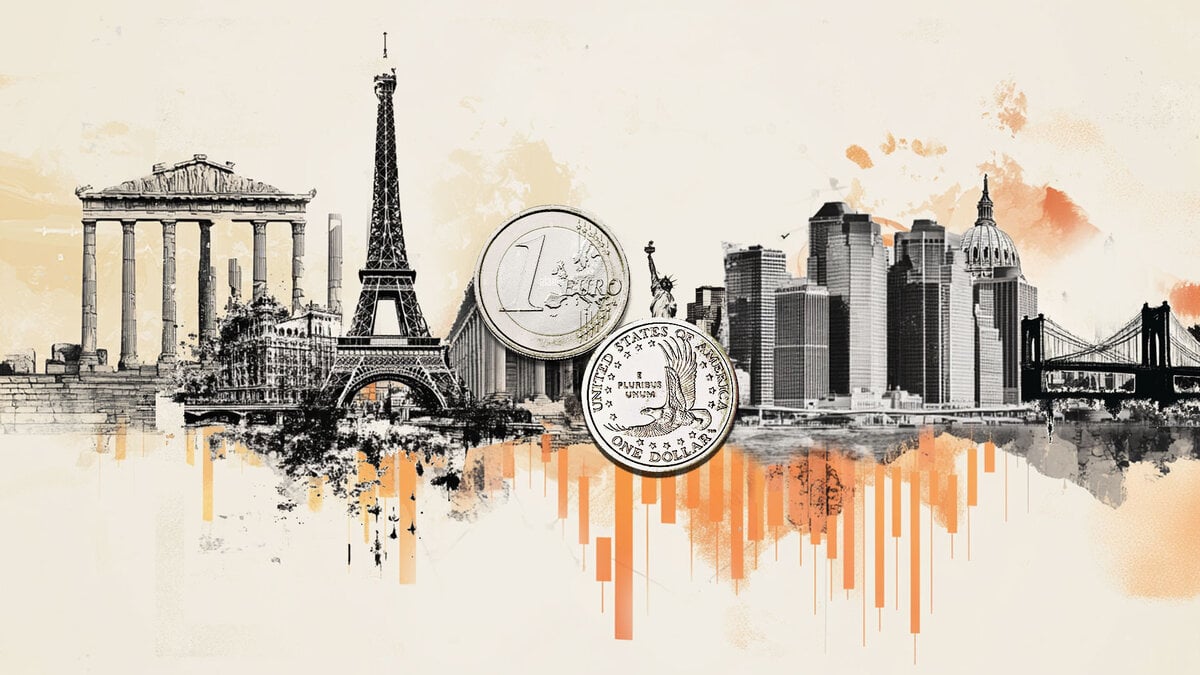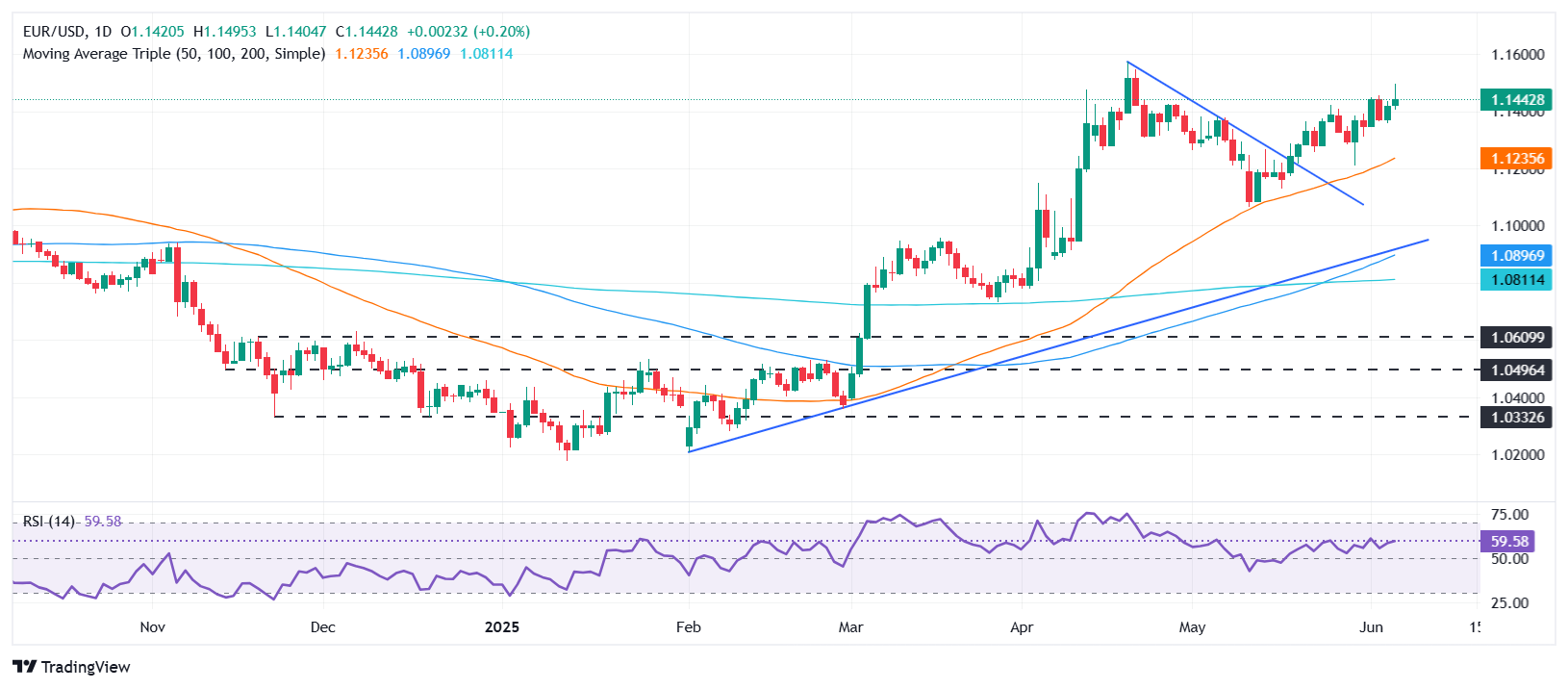Created
: 2025.06.06














![]() 2025.06.06 04:00
2025.06.06 04:00
EUR/USD holds onto earlier gains of over 0.20% after the European Central Bank (ECB) grabbed the headlines, reducing rates but leaving the door open for a pause at the upcoming July 24 meeting. At the time of writing, the pair trades at 1.1441 after bouncing off daily lows of 1.1404.
The ECB decided to reduce interest rates to 2%, as expected by market participants, although it has left the door open for a pause. The decision was not unanimous, with one dissenter, most likely Robert Holzmann, who, in the run-up to the meeting, favored a cut after the June or July meeting.
In the statement, the ECB outlined its meeting-by-meeting path and updated its projections for growth and inflation. At ECB President Christine Lagarde's press conference, she said that monetary policy is "well-positioned" around the current uncertain outlook, adding that the central bank is close to ending the easing cycle.
EUR/USD spiked sharply towards its daily high of 1.1498 before retreating somewhat to current exchange rate levels.
Across the pond, the US Bureau of Labor Statistics confirmed signs of a cooling labor market, as jobless claims rose with more people filing for unemployment insurance. Meanwhile, the US trade deficit narrowed in April, according to the Bureau of Economic Analysis, as businesses eased front-loading of goods ahead of incoming tariffs.
Federal Reserve (Fed) speakers grabbed the headlines, led by Governor Adriana Kugler and regional Fed Presidents Patrick Harker and Jeffrey Schmid. The Greenback trimmed some of its earlier losses, as revealed by the US Dollar Index (DXY). The DXY, which tracks the buck's value against six peers, is virtually unchanged at 98.75.
EUR/USD traders' eyes are on the US Nonfarm Payroll figures, which are expected to decrease from 177K to 130K in May. The Unemployment Rate is projected to remain unchanged at 4.2%.
The table below shows the percentage change of Euro (EUR) against listed major currencies this week. Euro was the strongest against the US Dollar.
| USD | EUR | GBP | JPY | CAD | AUD | NZD | CHF | |
|---|---|---|---|---|---|---|---|---|
| USD | -0.82% | -0.85% | -0.16% | -0.56% | -1.16% | -1.28% | -0.34% | |
| EUR | 0.82% | -0.04% | 0.67% | 0.26% | -0.35% | -0.50% | 0.47% | |
| GBP | 0.85% | 0.04% | 0.74% | 0.29% | -0.30% | -0.46% | 0.52% | |
| JPY | 0.16% | -0.67% | -0.74% | -0.40% | -1.00% | -1.14% | -0.27% | |
| CAD | 0.56% | -0.26% | -0.29% | 0.40% | -0.58% | -0.75% | 0.22% | |
| AUD | 1.16% | 0.35% | 0.30% | 1.00% | 0.58% | -0.09% | 0.90% | |
| NZD | 1.28% | 0.50% | 0.46% | 1.14% | 0.75% | 0.09% | 0.98% | |
| CHF | 0.34% | -0.47% | -0.52% | 0.27% | -0.22% | -0.90% | -0.98% |
The heat map shows percentage changes of major currencies against each other. The base currency is picked from the left column, while the quote currency is picked from the top row. For example, if you pick the Euro from the left column and move along the horizontal line to the US Dollar, the percentage change displayed in the box will represent EUR (base)/USD (quote).
EUR/USD uptrend remains intact, but buyers seem reluctant to push prices to achieve a daily close above 1.1450. Momentum seems to be fading as depicted by price action and the Relative Strength Index (RSI). The RSI's slope is turning flat, an indication that bulls are taking a respite.
For a bullish continuation, the EUR/USD pair must close above 1.1454 on a daily basis. If surpassed, the pair could challenge the current week's peak of 1.1494, followed by 1.1500 and April highs near 1.1572, ahead of 1.16.
Conversely, if EUR/USD falls below the June 2 daily low of 1.1344, a move to 1.13 is on the cards. A breach of the latter would expose the 20-day Simple Moving Average (SMA) at 1.1284, followed by the 50-day SMA at 1.1218 and 1.1200.

The Euro is the currency for the 19 European Union countries that belong to the Eurozone. It is the second most heavily traded currency in the world behind the US Dollar. In 2022, it accounted for 31% of all foreign exchange transactions, with an average daily turnover of over $2.2 trillion a day. EUR/USD is the most heavily traded currency pair in the world, accounting for an estimated 30% off all transactions, followed by EUR/JPY (4%), EUR/GBP (3%) and EUR/AUD (2%).
The European Central Bank (ECB) in Frankfurt, Germany, is the reserve bank for the Eurozone. The ECB sets interest rates and manages monetary policy. The ECB's primary mandate is to maintain price stability, which means either controlling inflation or stimulating growth. Its primary tool is the raising or lowering of interest rates. Relatively high interest rates - or the expectation of higher rates - will usually benefit the Euro and vice versa. The ECB Governing Council makes monetary policy decisions at meetings held eight times a year. Decisions are made by heads of the Eurozone national banks and six permanent members, including the President of the ECB, Christine Lagarde.
Eurozone inflation data, measured by the Harmonized Index of Consumer Prices (HICP), is an important econometric for the Euro. If inflation rises more than expected, especially if above the ECB's 2% target, it obliges the ECB to raise interest rates to bring it back under control. Relatively high interest rates compared to its counterparts will usually benefit the Euro, as it makes the region more attractive as a place for global investors to park their money.
Data releases gauge the health of the economy and can impact on the Euro. Indicators such as GDP, Manufacturing and Services PMIs, employment, and consumer sentiment surveys can all influence the direction of the single currency. A strong economy is good for the Euro. Not only does it attract more foreign investment but it may encourage the ECB to put up interest rates, which will directly strengthen the Euro. Otherwise, if economic data is weak, the Euro is likely to fall. Economic data for the four largest economies in the euro area (Germany, France, Italy and Spain) are especially significant, as they account for 75% of the Eurozone's economy.
Another significant data release for the Euro is the Trade Balance. This indicator measures the difference between what a country earns from its exports and what it spends on imports over a given period. If a country produces highly sought after exports then its currency will gain in value purely from the extra demand created from foreign buyers seeking to purchase these goods. Therefore, a positive net Trade Balance strengthens a currency and vice versa for a negative balance.
![]()
Created
: 2025.06.06
![]()
Last updated
: 2025.06.06

FXStreet is a forex information website, delivering market analysis and news articles 24/7.
It features a number of articles contributed by well-known analysts, in addition to the ones by its editorial team.
Founded in 2000 by Francesc Riverola, a Spanish economist, it has grown to become a world-renowned information website.
We hope you find this article useful. Any comments or suggestions will be greatly appreciated.
We are also looking for writers with extensive experience in forex and crypto to join us.
please contact us at [email protected].
Disclaimer:
All information and content provided on this website is provided for informational purposes only and is not intended to solicit any investment. Although all efforts are made in order to ensure that the information is correct, no guarantee is provided for the accuracy of any content on this website. Any decision made shall be the responsibility of the investor and Myforex does not take any responsibility whatsoever regarding the use of any information provided herein.
The content provided on this website belongs to Myforex and, where stated, the relevant licensors. All rights are reserved by Myforex and the relevant licensors, and no content of this website, whether in full or in part, shall be copied or displayed elsewhere without the explicit written permission of the relevant copyright holder. If you wish to use any part of the content provided on this website, please ensure that you contact Myforex.
Myforex uses cookies to improve the convenience and functionality of this website. This website may include cookies not only by us but also by third parties (advertisers, log analysts, etc.) for the purpose of tracking the activities of users. Cookie policy